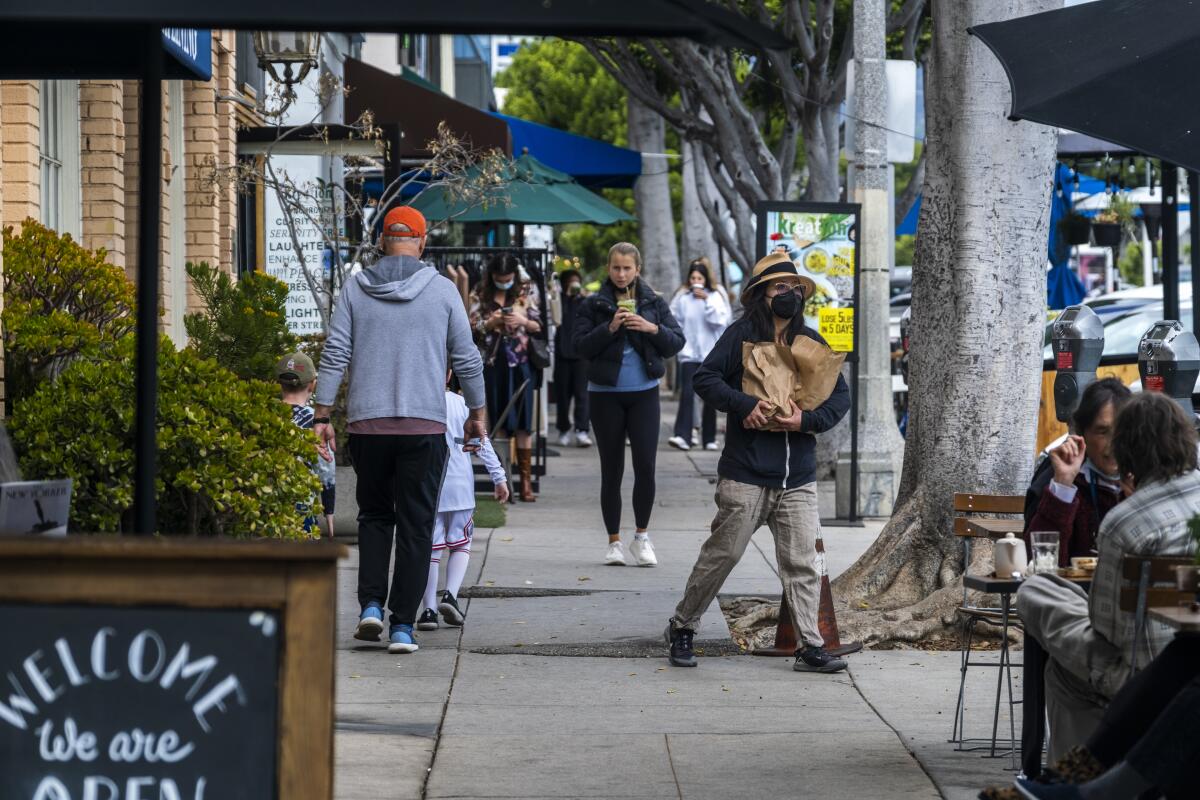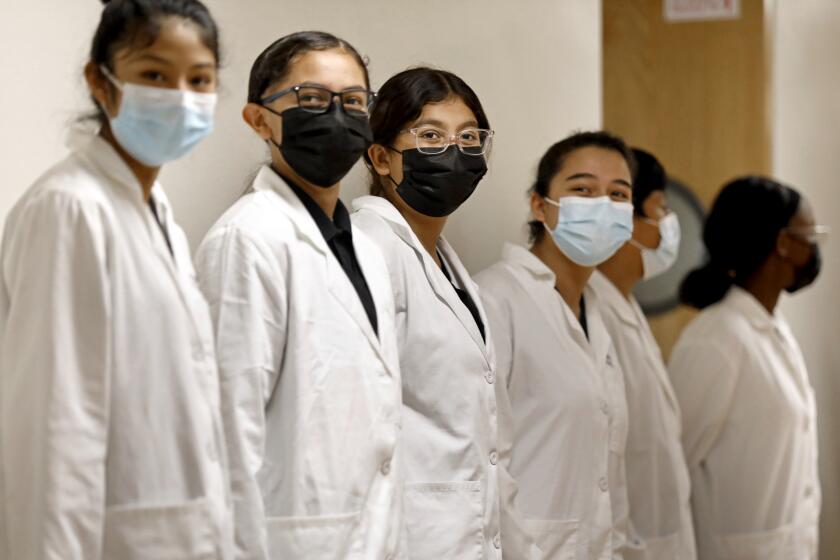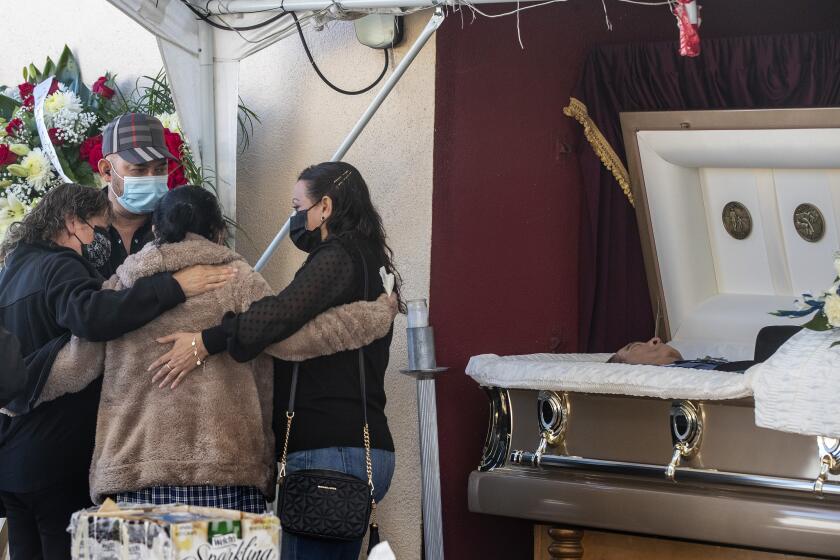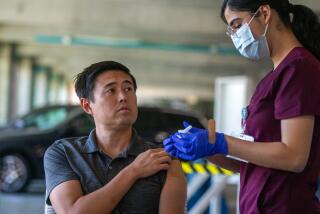Despite coronavirus uptick, there’s hope L.A. County can avoid another surge

- Share via
Despite a recent rise in coronavirus cases, Los Angeles County’s public health director said this week she remained hopeful the region could avoid another major spike by taking sensible precautions.
The number of newly reported coronavirus cases in L.A. County has risen by 42% over the last two weeks, from an average of 725 a day to 1,030, according to a Times data analysis. On a per capita basis, L.A. County is now averaging about 71 cases a week for every 100,000 residents; transmission went from being moderate to substantial two weeks ago, when the rate climbed above 50.
In central New York State, health officials are closely watching even newer Omicron subvariants — BA.2.12 and BA.2.12.1 — which are estimated to be 25% more contagious than their parent subvariant, BA.2, that is dominant nationwide.
BA.2.12.1 has been detected in California, said Dr. Peter Chin-Hong, a UC San Francisco infectious-diseases expert.
Some experts say people who have eased up on precautions may want to be more cautious to avoid infection.
Yet there remain some optimistic signs that the latest increase in cases could end up being more of a blip than the start of a new surge.
The share of emergency room visits in L.A. County related to the coronavirus remained low last week, at just 3%. Officials would express a medium level of concern if that figure was 5% or greater, and a high level of concern if it was more than 10%. During the peak of the Omicron surge in early January, 29% of emergency room visits were related to COVID-19, county Public Health Director Barbara Ferrer told reporters Thursday.
On Thursday, 228 coronavirus-positive individuals were hospitalized in L.A. County. That’s a decrease of 21% from two weeks ago and nearing the lowest single-day patient count recorded throughout the entire pandemic, which was recorded 10 months ago, when the tally was 212.
Another point of worry would be if the amount of coronavirus detected in sewage systems doubled over a 10-day period. But, for now, the coronavirus levels in wastewater have remained stable, Ferrer said.
She emphasized that residents should remain cautious, and urged them to wear masks, stay home if they’re sick, get up to date on their shots, and test before social gatherings.
California is relaxing quarantine recommendations for people exposed to the coronavirus but remain asymptomatic. L.A. and other counties can keep stricter rules in place or follow the state’s COVID-19 guidance.
And unlike Philadelphia, which next week will resume an indoor mask mandate, L.A. County is nowhere close to issuing a similar order — though local officials still strongly recommend wearing them in indoor public settings.
Ferrer said L.A. County would require masks again if the region’s coronavirus-positive hospitalizations numbers hit a threshold set by the U.S. Centers for Disease Control and Prevention.
L.A. County’s COVID-19 Community Level, which is based on hospitalization utilization as defined by the CDC, remains low. That level would need to be considered high to trigger a return to universal indoor masking, Ferrer said.
One way L.A. County would hit that threshold would be if the weekly rate of new coronavirus-positive hospital admissions were more than quadruple what it is now.
Waiting that long for a mandatory mask order, however, might be too late to avoid the hospital system from facing significant trouble, Ferrer said.
A hypothetical situation in which the return of a mask order in L.A. County might make sense ahead of hitting the CDC’s threshold is the rise of a new variant for which vaccine-induced immunity is no longer protective against serious illness and death.
In addition, “were we to see skyrocketing cases, we might not want to wait until hospitalizations are so high before, again, we go ahead and require masking again,” Ferrer said.
L.A. County is not seeing skyrocketing cases now. The pace of L.A. County’s increase in cases in the last three weeks is nothing like the near-vertical spike seen during the Omicron explosion last fall and winter. For instance, over the last two weeks of 2021, the coronavirus case rate climbed by 580%, and by early January, peaked at about 42,000 cases a day.
“We’re not seeing an exponential growth in cases, we’re seeing sort of these steady, small increases — somewhere between 2%, 3% rise every day in cases,” Ferrer said. Still, she added, “these increases are nevertheless concerning, and they do serve as a reminder that transmission now across the county is substantial.”
Case rates still remain flat over the last two weeks in San Diego, Riverside and Ventura counties. But other areas are also seeing increases.
Orange County is now averaging 42 cases a week for every 100,000 residents, up 47% from two weeks ago; San Bernardino County’s rate is 86, up 176%. San Francisco now has one of the state’s highest case rates, at 116, up 16%.
“This is not a perfect picture by any stretch of the imagination in California. And it’s something that we need to be continuously vigilant about,” Dr. George Rutherford, a UC San Francisco epidemiologist, said at a campus meeting Friday.
Chin-Hong of UC San Francisco said he’s still dining indoors at restaurants but is being more careful about wearing masks anywhere inside the venue when not at his table.
Chin-Hong suggested that people attending gatherings of multiple households take rapid tests before meeting if they plan to meet unmasked indoors. It’s lower risk to meet outdoors, or, if meeting indoors, to remain masked.
People may have various thresholds for how much risk they want to take to meet up. People who may want to take less risk may be those who are older, immunocompromised, not yet boosted, or unvaccinated; those who live with higher-risk people; and people who can’t afford to get infected because they don’t want to be required to stay home for at least five days, Chin-Hong said.
Ferrer, the L.A. County public health director, also suggested that people ask those they’re planning to meet if they’re vaccinated and boosted.
These steps reduce risk of transmission, but don’t eliminate it.
Public health officials have primarily attributed the recent rises to a combination of waning natural and vaccine-induced immunity, the lifting of certain public health measures and the proliferation of BA.2 — a subvariant of Omicron thought to be 30% to 80% more contagious than its ancestor.
“Our hope is that it does level off,” Ferrer said. “Our hope is that people will recognize that we’ve got a more infectious subvariant circulating, be more careful, put that mask on in these higher-risk settings, go ahead and get tested when you’re gathering, be sensible to try to avoid either a reinfection or a new infection.”
Chin-Hong said the newest subvariants detected in central New York are “definitely raising eyebrows.” But he remained hopeful that California would avoid the kind of significant second Omicron surge observed in Britain, which had to contend with a fresh deluge of coronavirus-positive patients requiring hospital care.
California may be better off in avoiding a significant second Omicron surge because it eased pandemic-related rules, like mask mandates, later than Britain did, Chin-Hong said. The decision to lift restrictions earlier, while cases were still high, may have set up Britain for a tougher spring. Britain’s weekly COVID-19 death rate climbed nearly 80% between early March to early April.
BA.2 is now easily the most dominant version of the coronavirus circulating in the United States, and made up an estimated 86% of samples nationally over the week ending Saturday, according to the U.S. Centers for Disease Control and Prevention.
Here’s what you need to know amid a holiday season — including Easter, Ramadan and Passover — spring break and events like Coachella and Stagecoach.
Officials say the easily spread subvariant is the culprit behind significant increases in coronavirus cases in parts of Europe, Asia and the United States.
In L.A. County, however, the uptick in infections has yet to trigger corresponding rises in the number of people hospitalized with, and dying from, COVID-19. However, public health officials have long noted that it can take weeks for this domino effect to play out, and L.A. County’s coronavirus bump is still relatively new.
“We may not yet be seeing a corresponding increase in hospitalizations because of the customary delay in hospitalizations increasing after cases increase,” Ferrer said.
But unlike earlier in the pandemic, where there was almost a clockwork cadence from infections to hospitalizations to deaths, some officials and experts have said that’s no longer a given.
There are a couple of reasons for that optimism. First is L.A. County’s high level of vaccine coverage — roughly 79% of all residents have gotten at least one dose, and 71% are fully vaccinated, health data show.
Effective therapeutics are also now available, though finding them can be a challenge. Studies have also shown that Omicron tends to cause less severe illness on the whole than preceding strains — such as the Delta variant that spawned last summer’s surge.
And while surviving a Delta infection didn’t preclude against an Omicron infection, surviving an earlier Omicron subvariant over the winter will likely offer a degree of protection against the Omicron BA.2 subvariant.
Over the last week, an average of 13 COVID-19 deaths have been reported each day, Ferrer said — down from about 40 a month ago.
For the first time in a decade, the mortality rate for Latinos in L.A. County surpasses that of white residents, starting in 2020 — with the pandemic.
Officials are also monitoring the Omicron XE subvariant, which preliminary data suggests could be 10% more contagious than BA.2. XE has not been detected in L.A. County, but two cases have been identified elsewhere in California, Ferrer said.
Any infection, even one that ultimately prove to be mild or asymptomatic, carries certain risks, officials say. After all, every new case represents another opportunity for the coronavirus to mutate in potentially harmful ways, as demonstrated by the emergence of the Delta and Omicron variants.
“The more infections we have, the more chances there are for new variants and subvariants to emerge,” Ferrer said. “So this, for all of us, should be another reason why it’s important that we do increase those vaccination and booster rates.”
More to Read
Sign up for Essential California
The most important California stories and recommendations in your inbox every morning.
You may occasionally receive promotional content from the Los Angeles Times.


















